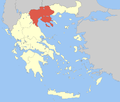| Polygyros Πολύγυρος | |
|---|---|
| Municipality | |
 Polygyros from east Polygyros from east | |
  | |
| Coordinates: 40°22′N 23°26′E / 40.367°N 23.433°E / 40.367; 23.433 | |
| Country | Greece |
| Administrative region | Central Macedonia |
| Regional unit | Chalkidiki |
| Government | |
| • Mayor | Georgios Emmanouil (since 2023) |
| Area | |
| • Municipality | 947.4 km (365.8 sq mi) |
| • Municipal unit | 470.9 km (181.8 sq mi) |
| Elevation | 560 m (1,840 ft) |
| Population | |
| • Municipality | 21,351 |
| • Density | 23/km (58/sq mi) |
| • Municipal unit | 11,382 |
| • Municipal unit density | 24/km (63/sq mi) |
| • Community | 7,779 |
| Time zone | UTC+2 (EET) |
| • Summer (DST) | UTC+3 (EEST) |
| Postal code | 631 00 |
| Area code(s) | 23710 |
| Vehicle registration | ΧΚ |
| Website | polygyros |
Polygyros (Greek: Πολύγυρος) is a town and municipality in Central Macedonia, Greece. It is the capital of Chalkidiki.
Geography
Polygyros town (pop. 7,779 at the 2021 census) is built in the shape of an amphitheatre on a plateau on the south west side of the mountain Cholomontas. It is south of Greek National Road 16 (Thessaloniki - Arnaia). Polygyros is located SE of Thessaloniki, NE of Nea Moudania, NW of Sithonia and SW of Arnaia. The municipal unit (the municipality before 2011) has a population of 11,386 inhabitants (2021) and a land area of 470.933 km. Other large communities in the municipal unit are Ólynthos (pop. 1,053), Taxiárchis (742), and Vrástama (944).
Climate
Polygyros has a hot-summer Mediterranean climate (Köppen: Csa), closely bordering on a humid subtropical climate (Köppen: Cfa) with relatively cold winters and relatively hot summers due to its elevation.
| Climate data for Polygyros town (580m) | |||||||||||||
|---|---|---|---|---|---|---|---|---|---|---|---|---|---|
| Month | Jan | Feb | Mar | Apr | May | Jun | Jul | Aug | Sep | Oct | Nov | Dec | Year |
| Mean daily maximum °C (°F) | 7.3 (45.1) |
10 (50) |
13 (55) |
15 (59) |
21.2 (70.2) |
25.8 (78.4) |
27.7 (81.9) |
29.1 (84.4) |
25 (77) |
20.9 (69.6) |
14.4 (57.9) |
10.1 (50.2) |
18.3 (64.9) |
| Mean daily minimum °C (°F) | 1.8 (35.2) |
3.5 (38.3) |
6.5 (43.7) |
8.2 (46.8) |
13.1 (55.6) |
17.9 (64.2) |
20.2 (68.4) |
21.1 (70.0) |
17.8 (64.0) |
13.9 (57.0) |
9.6 (49.3) |
6 (43) |
11.6 (53.0) |
| Average precipitation mm (inches) | 49.7 (1.96) |
21.1 (0.83) |
52.9 (2.08) |
72.4 (2.85) |
33.7 (1.33) |
77.3 (3.04) |
44.2 (1.74) |
13.8 (0.54) |
33 (1.3) |
35.7 (1.41) |
74.5 (2.93) |
96.5 (3.80) |
604.8 (23.81) |
| Source: http://penteli.meteo.gr/stations/polygyros/ (2019 - 2020 averages) | |||||||||||||
Name
There are different speculations about the origin of Polygyros' name. Some claim that it comes from the combination of poly (much) and geros (strong), because of the healthy climate. Others believe that the words poly and ieros (sacred) have given the present name, because of an ancient temple in the area. Also an old landowner, named Polyaros, offers a possible etymology. A further potential source could be from poly and gyros, referring to the residents' dietary habits. According to another possible etymology, the name derives from poly and gyros (round), possible due to the town's amphitheatric position.
Municipality
The municipality Polygyros was formed at the 2011 local government reform by the merger of the following 4 former municipalities, that became municipal units:
- Anthemountas
- Ormylia
- Polygyros
- Zervochoria
The municipality has an area of 947.417 km, the municipal unit 470.933 km. The municipality includes the villages of Vrastama, Taxiarchis, Ormylia, Olynthos, Gerakini and Kalives.
History




Antiquity
Some situate in the broader area of modern Polygyros the ancient city of Apollonia. Apollonia was one of the 32 cities, which, under the leadership of the Olynthus, constituted the Koinon ton Chalkideon (Chalkidian League). The Koinon was destroyed in 379 BCE by the Spartans, while in 348 BCE Philipp II of Macedon annexed the whole Chalcidice into the Macedonian Kingdom. In 168 BCE Chalcidice was subjected by the Romans.
Byzantine and Ottoman Era
Further information: Byzantine Greece and Ottoman GreeceThe town of Polygyros is first mentioned in a medieval imperial document, chryssovoulon (with golden stamp), of Eastern Roman Emperor Nikephoros III Botaneiates about 1080 CE. In 1430, as the rest of the Eastern Roman Empire, Polygyros was conquered by the Ottomans and belonged to the Sanjak of Thessaloniki. On 17 May 1821 the people of Polygyros rose against the Ottoman authority and managed, temporarily, to expel the Ottoman guard. Polygyros, such as other villages of the peninsula, were burned by the Ottomans.
Many residents of Polygyros also took part in the 1854's unsuccessful revolutionary movement against the Ottomans.
Modern Era
Finally, on November 2, 1912 the Greek army, as one of the victors of the First Balkan War, entered Polygyros and incorporated the town in the Greek State.
Culture
Polygyros is famous for its carnival celebrations, which attracts visitors from all over Greece. A nearby location called Panagia (Virgin Mary) is the setting of a famous religious celebration on August 15. Also, cultural societies are active in the fields of folk music and dance. Classic and modern music is cultivated in the municipal conservatory. There is a Folklore Museum in the town, opened in 1998.
Sports
Niki (victory) is the name of Polygyros' football club, which participates in the Greek National Fourth Division Professional League. AOP (Athletic Club of Polygyros) is the local basketball team, participant in the Third National Basketball Division.
Landmarks
The Archaeological Museum of Polygyros has exhibits containing findings from all over Chalkidiki and referring to paleolithic and neolithic age, geometric, archaic, classic, hellenistic and Roman period.
Historical population
| Year | Community | Municipal unit | Municipality |
|---|---|---|---|
| 1981 | 5,239 | - | - |
| 1991 | 4,501 | 10,218 | - |
| 2001 | 6,227 | 10,444 | - |
| 2011 | 7,459 | 11,386 | 22,048 |
| 2021 | 7,779 | 11,382 | 21,351 |
People
- Margaritis Schinas, politician.
- Christos Zabounis, editor.
- Fonis Zoglopitis (1930–2015), painter.
See also
References
- Municipality of Polygyros, Municipal elections – October 2023, Ministry of Interior
- ^ "Αποτελέσματα Απογραφής Πληθυσμού - Κατοικιών 2021, Μόνιμος Πληθυσμός κατά οικισμό" [Results of the 2021 Population - Housing Census, Permanent population by settlement] (in Greek). Hellenic Statistical Authority. 29 March 2024.
- ^ "Population & housing census 2001 (incl. area and average elevation)" (PDF) (in Greek). National Statistical Service of Greece.
- Babiniotis, G. (1998). Lexiko tis Neas Ellinikis Glossas. Kentro Lexikologias. Athina.
- "ΦΕΚ A 87/2010, Kallikratis reform law text" (in Greek). Government Gazette.
- D. C. Samsaris, Romans and Chalcidice (in Greek), Μακεδονικά 25 (1985-86) 33-46 ="Πρώτο Πανελλήνιο Συμπόσιο "Ιστορία και Αρχαιολογία της Χαλκιδικής"". Archived from the original on 2014-12-25. Retrieved 2014-12-25. Πρώτο Πανελλήνιο Συμπόσιο "Ιστορία και Αρχαιολογία της Χαλκιδικής", Πολύγυρος, 7-9 Δεκεμβρίου 1984, σ. 113
External links
| Administrative division of the Central Macedonia Region | ||
|---|---|---|
| ||
| Regional unit of Chalkidiki |  | |
| Regional unit of Imathia | ||
| Regional unit of Kilkis | ||
| Regional unit of Pella | ||
| Regional unit of Pieria | ||
| Regional unit of Serres | ||
| Regional unit of Thessaloniki | ||
| ||
| Subdivisions of the municipality of Polygyros | |
|---|---|
| Municipal unit of Anthemountas |
|
| Municipal unit of Ormylia | |
| Municipal unit of Polygyros |
|
| Municipal unit of Zervochoria |
|